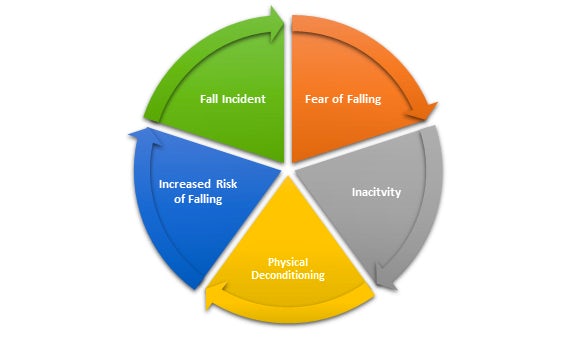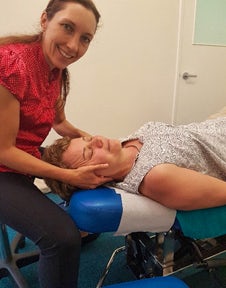
Why are falls so concerning for elderly?
Falling is one of the most common cause of injury in any age population, but falls are a major health concern for elderly aged 65 or above.
In older Australians, falls are the leading cause of unintentional injury, nearly 1 in 3 elderly Australians have experienced a fall in the past 12 months and 1 out of 5 required hospitalisation, which increase the risk of contracting other illness from the hospital.
With the increase of age, the risk of fall increases too, and because of that, the fear of falling becomes more common as people age, doesn’t matter if the person had or haven’t fallen before. The fear of falling may lead older people to avoid engaging in activities such as shopping, walking or participating in social activities. With the reduction of physical activity due to fear of falling, the muscles and the balance of the body will decondition and further increase the risk of falling, which then lead to more fear, so on and so forth. This is a vicious cycle of fear of falling and overcoming the fear can help you stay active, maintain your physical health and prevent future falls.

Fear of Falling Cycle.
Causes and Risk Factors of Falling
There are many causes of a fall and it doesn’t necessarily because you are not concentrating or clumsy. The top 3 reasons why an older individual might have a fall include:
1. Aging-related changes to the body – as a part of normal aging, our bodies changes gradually over the years and here are a few things that you might notice:
a. Slower reaction time
b. Poor eyesight
c. Muscle weakness
d. Balance issue
These changes might affect an older individual’s gait or ability to react quickly to a fall and result in a fall injury.
2. Hazards in and around the house – Almost 70% of falls occur in and around the house of older individuals. Some common household hazards include:
a. Unsafe footwear – narrow heels or loose slipper
b. Trip hazards – rugs, floor mats and electrical cords
c. Slippery or uneven surfaces
d. Poor lightning
Some common risk factors or conditions that increase the risk of a person falling include:
- History of previous fall – if you have fallen more than once in the past 6 months, you are more likely to experience a fall again.
- Low blood pressure – Low blood pressure may make older people feel light-headed, dizzy or unsteady.
- Postural hypotension – a condition where the blood pressure drops when a person changes position from sitting to standing.
- Incontinence – you may need to rush to the toilet often, which increase the risk of falling, especially at night time.
- Stroke, Parkinson’s disease and arthritis – There conditions affect the way you move and react to a fall.
- Diabetes – it can affect your blood sugar level, your eyesight and your ability to feel your feet and legs.
- Depression – depression medication may increase the risk of falling
- Alzheimer’s disease – become less aware of their surroundings and less able to react quickly.
- Keep Active
Physical activity provides long term benefits that will decrease your risk of falling significantly. With approval from your doctor, try engaging in gentle activities such as walking regularly, water workout, Tai Chi and more. By improving your overall muscle strength, balance, coordination and flexibility, you can greatly reduce your risk of falling. - Remove home hazards
As we mentioned before, try to look around the house and identify the hazards and remove them as soon as possible. Get someone to help with removing the hazards instead of doing it all by yourself to make sure you don’t injury yourself while trying to make your home safe. - Wear suitable footwear
Change footwear that has high heels, floppy slippers and shoes with slick soles to prevent fall. - Light up your home
Make your home a little brighter to reduce your risk of tripping over an object and fall. - Utilise assistive devices
If you are generally unsteady due to some conditions or disability, please consider getting a cane or walker to assist you and keep you steady.
How to prevent fall?
Instead of fearing fall and fall into the vicious cycle, try these simple fall-prevention strategies:
How we at Lakeside Chiropractic may assist with Falls!
 If you have had a fall, we can send you for x-rays that are bulk billed to check for any fractures and crush injuries to vertebrae. We will do a thorough examination to assess your injuries and see what steps are necessary to rectify your injuries. We treat fractures in our practice with Low level laser that speeds up healing time.
If you have had a fall, we can send you for x-rays that are bulk billed to check for any fractures and crush injuries to vertebrae. We will do a thorough examination to assess your injuries and see what steps are necessary to rectify your injuries. We treat fractures in our practice with Low level laser that speeds up healing time.
We acknowledge that fall prevention is critical to an elderly’s safety and overall health, therefore, we may help by loosen up some of your joints and muscles, allowing you to move better and steadier. Moreover, we can prescribe some exercise programs to strengthen your lower limbs and core muscles to help building your confidence in walking and not fall into the fear of falling cycle and decondition.
Lakeside chiropractic is located in Joondalup in Perth’s north and has visitors from many different suburbs including, Padbury, Kinross, Mindarie, Sorrento, Iluka, Carramar, Currambine, Tapping, Pearsall, Hocking and Woodvale. HICAPS Facilities available on site for major private health insurers (NIB, HCF, HBF, AHM, HCI and HIF) and also a part of the Medibank preferred practitioner and BUPA Members first network. If you would like to discuss any concerns, have any enquires or wish to book an appointment; feel free to contact one of our friendly staff on 9300 0095 or visit our website at www.lakesidechiro.com.au.



